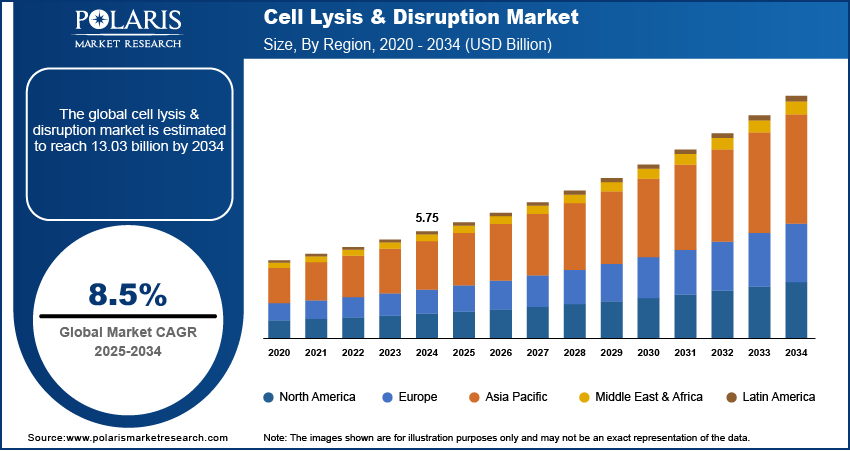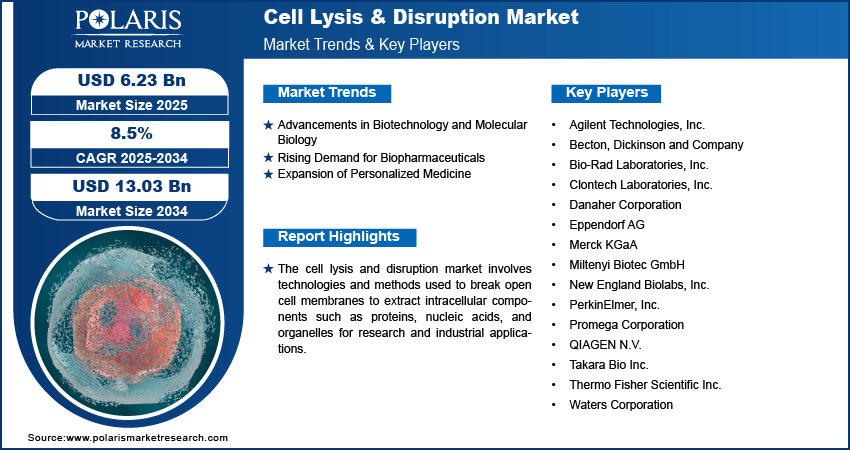
Global Cell Lysis & Disruption Market Share, Size, Trends, Industry Analysis Report, By Application (Protein Isolation, Downstream Processing, Cell Organelle Isolation, Nucleic Acid Isolation); By Technique; By Product; By End-Use; By Region; Segment Forecast, 2023 – 2032
- Published Date:May-2023
- Pages: 118
- Format: PDF
- Report ID: PM2090
- Base Year: 2022
- Historical Data: 2019-2021
Report Outlook
The Global cell lysis & disruption market was valued at USD 5,217.75 Million in 2022 and is expected to grow at a CAGR of 9.1% during the forecast period. Global Cell lysis and disruption are crucial techniques in molecular biology, biotechnology, and biochemistry that involve breaking open cells to release their cellular contents. These techniques are widely used in various applications, such as protein extraction, nucleic acid extraction, enzyme production, drug discovery, and bioprocessing.

To Understand More About this Research: Request a Free Sample Report
Cell lysis is the process of breaking open cell membranes, leading to the release of cellular contents into the surrounding solution. It is an essential step in many biological and biochemical experiments as it allows access to intracellular components, such as proteins, nucleic acids, and organelles, for further analysis or downstream processing.
There are several methods for cell lysis and disruption, depending on the type of cells, the desired yield and quality of the cellular contents, and the specific application. Some common methods include mechanical disruption, chemical lysis, enzymatic lysis, and physical methods such as freeze-thaw cycles, sonication, and pressure-based methods.
Mechanical disruption involves physically breaking open cells using mechanical forces such as grinding, shearing, or homogenization. This method is suitable for larger cells or tissues and can be performed using various equipment, such as bead mills, high-pressure homogenizers, or sonicators.

For Specific Research Requirements, Request for a Sample Report
Industry Dynamics
Growth Drivers
Cell lysis and disruption techniques are experiencing significant growth in several areas, driven by various factors. One of the key factors contributing to the growth of cell lysis and disruption techniques is the expanding field of biotechnology. Biotechnology encompasses a wide range of applications, including recombinant protein production, gene expression analysis, genetic engineering, and bioprocessing, all of which require efficient cell lysis and disruption methods. The increasing demand for biologics, such as vaccines, enzymes, and antibodies, is also fueling the growth of cell lysis and disruption techniques, as these techniques are crucial for extracting intracellular components used in downstream processing.
Another area driving the growth of cell lysis and disruption techniques is drug discovery and development. These techniques play a crucial role in the extraction of cellular components used in screening and characterization of drug candidates, studying drug-target interactions, drug metabolism, and pharmacokinetics. With the growing demand for novel drug candidates and personalized medicine, the need for efficient cell lysis and disruption methods is on the rise.
Research in molecular biology and biochemistry is also driving the growth of cell lysis and disruption techniques. These techniques allow researchers to access and manipulate cellular contents, providing valuable insights into cellular functions, mechanisms, and pathways. As research in these fields continues to expand, the demand for efficient cell lysis and disruption methods is expected to increase.
The adoption of high-throughput technologies in research and industrial applications is another significant factor driving the growth of cell lysis and disruption techniques. High-throughput screening, genomics, proteomics, and other high-throughput techniques require rapid and efficient cell lysis and disruption methods to process large numbers of samples in a short time. The increasing adoption of these technologies is expected to drive the demand for efficient and automated cell lysis and disruption methods.
The expansion of the biotechnology and pharmaceutical industries worldwide is contributing to the growth of cell lysis and disruption techniques. These industries require efficient methods for the extraction of cellular components for research, development, and production of biologics, drugs, and other biotechnological products. As these industries continue to expand, the demand for cell lysis and disruption techniques is expected to grow.
The growth of cell lysis and disruption techniques is driven by various factors, including the expanding field of biotechnology, drug discovery and development, research in molecular biology and biochemistry, adoption of high-throughput technologies, and the expansion of the biotechnology and pharmaceutical industries. These techniques are vital for accessing and manipulating cellular components for a wide range of applications, making them essential tools in modern life sciences and biotechnology.
Report Segmentation
The market is primarily segmented based on Technique, Product, Application, End-Use, and region.
|
By Technique |
By Product |
By Application |
By End-Use |
By Region |
|
|
|
|
|
For Specific Research Requirements: Request for Customized Report
The Downstream Processing segment is expected to witness the fastest growth over forecast period
The downstream processing segment is expected to witness the fastest growth in the field of cell lysis and disruption. Downstream processing refers to the purification and isolation of target molecules from the disrupted cells, which is a crucial step in various biotechnological and pharmaceutical applications. Several factors are driving the growth of the downstream processing segment in the cell lysis and disruption market.
The growth of the downstream processing segment is the increasing focus on personalized medicine. Personalized medicine aims to provide tailored treatment options based on an individual's genetic makeup, and it requires the extraction and analysis of genetic material from patient samples. Cell lysis and disruption techniques are essential in extracting genetic material from cells for downstream processing, including DNA and RNA purification. The growing adoption of personalized medicine is expected to drive the demand for downstream processing techniques in cell lysis and disruption.
The protein isolation segment accounted for the largest market share in 2022
The protein isolation segment is a significant component of the cell lysis and disruption market, accounting for the largest market share. Protein isolation is a crucial step in many biotechnological and pharmaceutical applications, as it involves the extraction and purification of proteins from cells that have been lysed or disrupted. Several factors contribute to the dominance of the protein isolation segment in the cell lysis and disruption market.
The advancements in proteomics research and the increasing focus on drug discovery and development are also contributing to the growth of the protein isolation segment. Proteomics, which involves the study of the entire proteome (i.e., all proteins) of a cell or tissue, requires the isolation and characterization of proteins from complex biological samples. Protein isolation techniques play a critical role in proteomics research, enabling the identification and quantification of proteins, post-translational modifications, and protein-protein interactions.
The Pharmaceuticals & Biotechnology Companies segment accounted for the largest market share by end-use in 2022
The Pharmaceuticals & Biotechnology Companies segment is the largest market share by end-use in the cell lysis and disruption market. The increasing demand for novel drugs and therapies, production of biologics, and focus on personalized medicine and precision medicine are the key factors driving the dominance of this segment. Cell lysis and disruption techniques are crucial in various applications in the pharmaceuticals and biotechnology industry, making this segment a significant end-use segment in the cell lysis and disruption market.
Cell lysis and disruption techniques are critical in the early stages of drug discovery and development, as they are used to break open cells and release their contents, including proteins, nucleic acids, and other cellular components. These released cellular contents are then used for further analysis, such as target identification, validation, and screening, in the development of new drugs and therapies. The pharmaceuticals and biotechnology companies heavily rely on efficient and effective cell lysis and disruption techniques to obtain high-quality cellular materials for their research and development activities, driving the demand for cell lysis and disruption products in this segment.
The demand in Asia Pacific is expected to witness significant growth in 2022
The Asia Pacific region is expected to witness significant growth in the demand for cell lysis and disruption products. Asia Pacific is a rapidly growing market with a large population, expanding pharmaceutical and biotechnology industries, and increasing investments in research and development activities.
Asia Pacific is the rising focus on healthcare infrastructure development and advancements in healthcare practices. Several countries in the region, such as China, India, Japan, and South Korea, are investing significantly in their healthcare infrastructure and research capabilities to address the growing healthcare needs of their populations. This includes the establishment of new research institutes, academic institutions, and biopharmaceutical companies, which are driving the demand for cell lysis and disruption products for drug discovery, development, and production.
As the region witnesses an increasing trend of personalized medicine and precision medicine approaches, there is a growing need for cell lysis and disruption techniques for genetic testing, molecular profiling, and targeted therapies. The advancements in genomics technologies and the increasing adoption of precision medicine in Asia Pacific are expected to further fuel the demand for cell lysis and disruption products in the region.
Competitive Insight
Some of the major players operating in the global cell lysis & disruption market include Becton Dickinson & Company (BD), Bio-Rad Laboratories, BioVision, Inc., Cell Signaling Technology Inc., Claremont BioSolutions, LLC, Covaris, Danaher Corp., Roche Molecular Systems, Inc., Geno Technology Inc., Merck KGaA, Microfluidics International Corp., Miltenyi Biotec, Norgen Biotek Corp., NZYTech Lda, Parr Instrument Company, PromoCell GmbH, Qsonica LLC, STEMCELL Technologies Inc., and Thermo Fisher Scientific.
Recent Developments
- In September 2022, SCIENION and Cellenion launched the proteoCHIP LF 48 for label-free single-cell proteomics sample preparation on the cellenONE platform.
- In March 2022, Sanofi and IGM Biosciences, Inc. announced signing an exclusive worldwide collaboration agreement to create, develop, manufacture, and commercialize IgM antibody agonists against three oncology targets and three immunology/inflammation targets.
Global Cell Lysis & Disruption Market Report Scope
|
Report Attributes |
Details |
|
Market size value in 2023 |
USD 5,698.83 million |
|
Revenue forecast in 2032 |
USD 12,500.41 million |
|
CAGR |
9.1% from 2023 - 2032 |
|
Base year |
2022 |
|
Historical data |
2019 - 2021 |
|
Forecast period |
2023 - 2032 |
|
Quantitative units |
Revenue in USD million and CAGR from 2023 to 2032 |
|
Segments covered |
By Technique, By Product, By Application, By End-Use, By Region |
|
Regional scope |
North America, Europe, Asia Pacific, Latin America, Middle East & Africa |
|
Key companies |
Becton Dickinson & Company (BD), Bio-Rad Laboratories, BioVision, Inc., Cell Signaling Technology Inc., Claremont BioSolutions, LLC, Covaris, Danaher Corp., Roche Molecular Systems, Inc., Geno Technology Inc., Merck KGaA, Microfluidics International Corp., Miltenyi Biotec, Norgen Biotek Corp., NZYTech Lda, Parr Instrument Company, PromoCell GmbH, Qsonica LLC, STEMCELL Technologies Inc., and Thermo Fisher Scientific. |
FAQ's
key companies in cell lysis & disruption market are Becton Dickinson & Company (BD), Bio-Rad Laboratories, BioVision, Inc., Cell Signaling Technology Inc., Claremont BioSolutions, LLC, Covaris, Danaher Corp., Roche Molecular Systems, Inc.
The global cell lysis & disruption market expected to grow at a CAGR of 9.1% during the forecast period.
The cell lysis & disruption market report covering key segments are technique, product, application, end-use, and region.
key driving factors in cell lysis & disruption market are advancements in homeogenizers, instruments, and chemical lysis methods.
The global cell lysis & disruption market size is expected to reach USD 12,500.41 Million by 2032.
